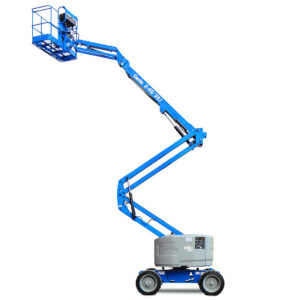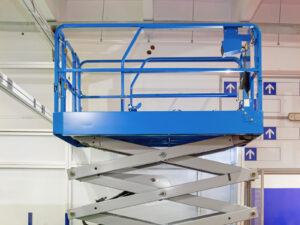What are mobile platforms?
 Mobile platforms also called lifts and basket platforms are classified as cranes, they are used on construction sites, in the service and industrial sectors. These devices are designed to transport and lift employees vertically and horizontally to a given workplace. They help people reach high places, where they cannot do without the intervention of an employee. They are designed in such a way that the transported and lifted person can efficiently and safely reach the assigned workplace, therefore they are a practical alternative to scaffolding and ladders.
Mobile platforms also called lifts and basket platforms are classified as cranes, they are used on construction sites, in the service and industrial sectors. These devices are designed to transport and lift employees vertically and horizontally to a given workplace. They help people reach high places, where they cannot do without the intervention of an employee. They are designed in such a way that the transported and lifted person can efficiently and safely reach the assigned workplace, therefore they are a practical alternative to scaffolding and ladders.
Mobile platforms are classified according to their design features, type of drive and the type of boom.
Usually, the classification of booms is based mainly on the design features of the devices, so we are able to divide them into the following groups:
- hanging mobile platforms,
- mast climbing work platforms,
- movable mobile platforms.
Suspended mobile platforms (on lifting ropes) consist of a working platform (gondola or basket), lifting ropes and safety ropes, a winch and the platform supporting structure. Rope winches are located on the supporting structure of the work platform or directly on it. The load-bearing structure can be installed on a specialized track, which is a permanent element of the structure, or on the roof of the building. The supporting rope is attached to the working platform by means of a hanger, and the platform can be placed on the rope in a single-point, two-point or multi-point manner.
Mast climbing work platforms (single-mast or double-masted) consist of one or two masts, a working platform that is carried over the mast (or masts), a chassis (base) resembling a tow truck on which the mast rests, and a drive unit with which the platform moves working. Typically, the mast is constructed from a truss structure, and the lifting mechanism uses a rack and pinion crane to move the work platform along the mast, while the undercarriage is made as a towing trolley.
Mobile platforms belong to a particularly popular group, as they are adapted to move on the road and are often used in works related to the maintenance of road infrastructure and tasks related to the protection of roadsides, and are divided into:
- Low-speed mobile platforms. They consist of a working platform, a chassis and a supporting structure combined with the chassis, on which the working platform is attached. They have a private two- or four-wheel drive, and the undercarriage can be either tracked or wheeled. They are powered by diesel or electric. The slow-moving platforms include telescopic, articulated, scissor lifts and articulated-telescopic platforms.
- Mobile mobile platforms are mounted on the trailer's chassis and adapted to be towed behind the vehicle. As special trailers, they are approved for road traffic.
- Self-propelled mobile platforms are platforms attached to a car chassis and approved for road traffic.
Due to the type of drive, mobile platforms are divided into:
- platforms with electric drive (from mains or battery),
- platforms with diesel drive,
- and manually powered platforms.
Mobile platforms are also divided according to the type of the boom. On this basis, we distinguish increases:
- scissor lift - load-bearing structure made of levers connected with a pin, thanks to which it allows to unfold the scissor mechanism, and thus sets the working platform in vertical motion.
- articulated - the load-bearing structure is fabricated with the guess of a broken joint of the mast,
- telescopic - supporting structure fabricated with the guess of a telescopic mast,
- articulated-telescopic - supporting structure combining solutions of articulated and telescopic structures.
The use of mobile platforms additionally depends on their technical parameters:
 Rated capacity Q [kg] - informs about the highest possible load that the platform can bear during normal operation.
Rated capacity Q [kg] - informs about the highest possible load that the platform can bear during normal operation.- Work platform dimensions [m] - work platform width and length (including platform extension).
- Maximum value of the working platform [m] - it shows the extreme vertical distance from the level of the mobile platform position on the ground.
- Working range of the work platform [m] - describes the horizontal range between the axis of rotation of the mobile mobile platform and the limit position of the work platform.
- Maximum working value [m] - the peak distance of the plumb line from the level of the movable mobile platform to the level where a person on the work platform is able to perform his work in a safe manner.
- Working area of the movable mobile platform - usable space of the working platform with its specified load capacity. The working area is the overall working range and the maximum working height of the platform.
- Platform lifting and lowering speed [m / s] - shows the rate of vertical movement of the platform with a nominal load.
The use of a mobile platform significantly improves work efficiency, allowing easy access for employees to get into high and difficult to access installations or parts of buildings. Performing a task with such advanced machines allows you to obtain the desired result, depending on what device is needed most: endurance. Mobile platforms are widely used in all possible work at heights, including building facades, trimming and cutting trees for work on power lines, in warehouse works, and even washing windows or glazing. Mobile platforms are also useful in the advertising industry, when they place billboards and advertisements at heights, as well as for fire brigade employees while extinguishing fires.
The use depends on the structure of the platform, the crane drive and the type of boom.
Completely different platforms will be used for works in heavy industry and assembly, and different ones for service works. Tracked platforms are intended only for industries working in closed terrain, parallel wheeled and self-propelled platforms work phenomenally throughout the advertising and service area, and wherever dynamics and practicality count.


































